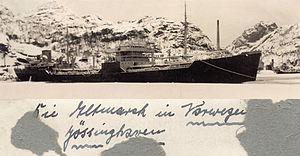
Back Altmark (1937) Czech Altmark (skib) Danish Altmark (Schiff) German نفتکش آلتمارک Persian Altmark (pétrolier ravitailleur) French Altmark (hajó) Hungarian Altmark (nave) Italian アルトマルク (船) Japanese Altmark (tanker) Dutch «Altmark» NB
 Altmark in early 1940, Jøssingfjord, Norway
| |
| History | |
|---|---|
| Name | Altmark |
| Namesake | Altmark |
| Builder | Howaldtswerke, Kiel |
| Laid down | 15 June 1936 |
| Launched | 13 November 1937 |
| Commissioned | 14 August 1939 |
| Renamed | Uckermark, 6 August 1940 |
| Fate | Destroyed by accidental explosion, 30 November 1942 |
| General characteristics [1] | |
| Displacement | 20,858 t (20,529 long tons) full load |
| Length | |
| Beam | 22 m (72 ft 2 in) |
| Draught | 9.3 m (30 ft 6 in) |
| Propulsion | 4 × MAN 9-cylinder diesel engines, 22,000 shp (16,405 kW), 2 shafts |
| Speed | 21.1 knots (39.1 km/h; 24.3 mph) |
| Range | 12,500 nmi (23,200 km) at 15 kn (28 km/h; 17 mph) |
| Complement | 94–208 |
| Armament |
|

Altmark was a German oil tanker and supply vessel, one of five of a class built between 1937 and 1939. She is best known for her support of the German commerce raider, the "pocket battleship" Admiral Graf Spee and her subsequent involvement in the "Altmark Incident". In 1940 she was renamed Uckermark[2] and used as supply tanker for the battleships Scharnhorst and Gneisenau during Operation Berlin before sailing to Japan on September 1942 as a blockade breaker.
Footage of Altmark appears briefly in the 1942 British wartime propaganda movie The Day Will Dawn.[3]
- ^ "Uckermark Technical Data". www.german-navy.de. Retrieved 2009-11-07.
- ^ "Uckermark (+1942)". WreckSite. The Wrecksite Read. Retrieved 5 January 2020.
- ^ French, Harold (1942-06-08), The Day Will Dawn (Drama, War), Paul Soskin Productions, retrieved 2022-02-25
© MMXXIII Rich X Search. We shall prevail. All rights reserved. Rich X Search